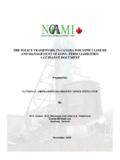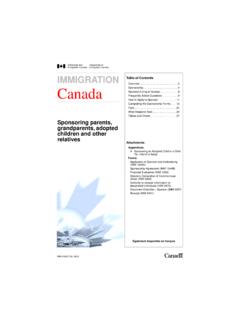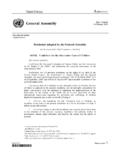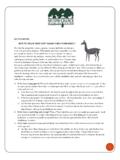Transcription of Past, Present, and Future Roles of Child Protective Services
1 23. Past, Present, and Future Roles of Child Protective Services Patricia A. Schene Abstract Contemporary social issues typically spring from historical roots, and, as this article points out, that is particularly true of the effort to find a balanced, fair, and helpful way Patricia A. Schene, , of responding to Child abuse and neglect. This article examines how today's Child pro- is a consultant in chil- tective Services system evolved from a past of almshouses, orphan trains, anticruelty dren and family Services societies, and legislation establishing the protection of children as a government func- and is associated with tion.
2 The author finds that the history of Child protection in the United States is the Graduate School of marked by a continuing, unresolved tension between the aim of rescuing children Public Affairs at the from abusive homes and that of strengthening the care their families can provide. University of Colorado, Against that backdrop, this article explains the structure of the typical Child Protective Denver. Services (CPS) agency (the unit within a broader public Child welfare department that focuses on abuse and neglect) and outlines the Roles in Child protection that are played by the police, the courts, private and public social service agencies, and the community at large.
3 According to the author's analysis, the fundamental challenges facing CPS can be captured in two questions regarding appropriate boundaries for the agency: Which situations require the agency's intervention? And how can the broader resources of the community be mobilized in the effort to protect children? T. he protection of children is a value shared by all cultures and com- munities around the globe. In almost all societies, responsibility for raising children well and preparing them for adulthood goes beyond the parents and is shared, to some degree, by the community at large.
4 The community's investment in the well-being of its children is reflected in cultural mores and social norms, and in legal frameworks that permit intervention in individual families when children are abused or neglected. In the United States, independence, privacy, and parental rights are highly prized. The legal system supports the right of families to rear their children according to their own values, and requires evidence of danger or harm before the state may invade the sanctity of the home to protect chil- ,2 Given the value society places on privacy, even neighbors and The Future of Children PROTECTING CHILDREN FROM ABUSE AND NEGLECT Vol.
5 8 No. 1 Spring 1998. 24 THE Future OF CHILDREN SPRING 1998. friends are often reluctant to informally intervene into family relation- ships. Controversy surrounds the work of Child protection because it juxta- poses the need for social intervention to protect children and the inherent rights of parents. As a result, efforts to improve upon the nation's system of Child protection often aim to find a balance between these competing values. The formal system through which this society responds to Child abuse and neglect is now largely a governmental one, although in the past, private Child advocacy and Child welfare agencies were the leaders in actions on behalf of vulnerable children.
6 Today, primary responsibility for Child pro- tection is vested in public Child Protective Services (CPS) agencies, which receive, investigate, and respond to reports of Child abuse and neglect. These agencies are usually linked to Child welfare departments with broader responsibilities, which include foster care and adoption. Both are typically housed within state or county departments of social Services . CPS functions are funded through state or local authorities and are governed by state statutes, although they have been shaped by federal leadership, legislation, and funding.
7 At the local level, the work of CPS is done in close coordina- tion with the courts, law enforcement agencies, and local social service providers. This article first reviews the history of the nation's response to Child maltreatment, tracing the shift in responsibility from private charities to public agencies. It also documents how efforts to provide substitute homes for children whose parents abuse or neglect them have overshad- owed efforts to strengthen vulnerable families so children can remain at home. Second, the current role of CPS is outlined and discussed in rela- tion to the other organizations (such as the courts) that contribute to Child protection.
8 Last, two key challenges now confronting the nation's Child protection system are briefly discussed: the difficulty of determining which cases should be served by CPS, which is a relatively intrusive and authoritative intervention into family life; and the importance of involv- ing other community members and organizations in the effort to protect children. Historical Overview protect them. The family support approach, The history of the nation's response to Child by contrast, focuses on ameliorating the abuse and neglect has been marked by a ten- social and environmental factors that con- sion between two missions: an emphasis on tribute to parental stress and Child maltreat- rescuing children from abusive or neglectful ment.
9 The Child rescue orientation was evi- families on the one hand, and efforts to sup- dent even in colonial times, while the family port and preserve their families on the other. support philosophy's earliest roots can be The contemporary debate over the priority found in the social Services orientation of given to these competing goals, waged in the progressive movement in the early twen- the press and in scholarly journals,3,4 is actu- tieth ally more than 100 years old. The Child rescue orientation is reflected in a long- 1700s and 1800s: Indenture and standing tendency to see Child maltreatment Institutions as arising from poverty and parental irre- The legal basis for efforts to protect needy sponsibility, and so to emphasize the children in colonial times rested on the removal of children from their homes to English Poor Law of 1601, which placed Past, Present, and Future Roles of Child Protective Services 25.
10 Public responsibility for the poor in the The demands that urbanization, indus- hands of local The doctrine trialization, and immigration placed on poor known as parens patriae, or the ruler's power and working-class families in the late to protect minors, was viewed as justification nineteenth century left many children unat- for governmental intervention into the tended. Child vagrancy became an increas- parent- Child relationship, either to enforce ingly visible problem. In 1853, a young parental duty or to supply substitute care for minister named Charles Loring Brace the The attention of community lead- responded to the huge numbers of home- ers, philanthropists, and social reformers less, ragged, hungry children prowling who were concerned about Child abuse and the streets of New York City by forming the neglect focused primarily on the children of Children's Aid Society to rescue those chil- the poorest families and on those who were dren.








